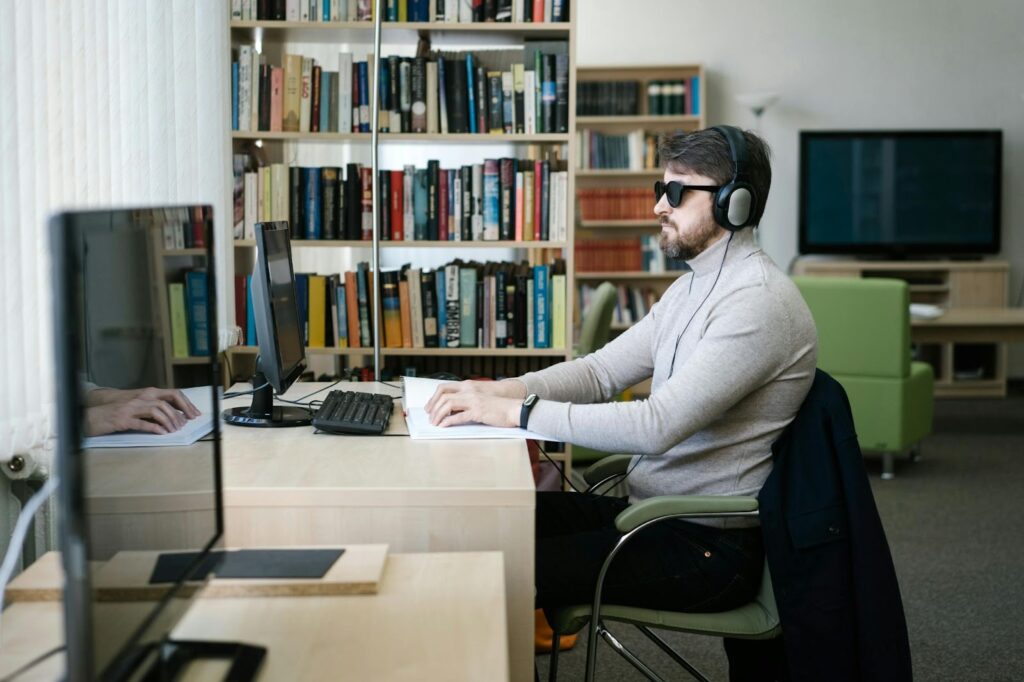It is impossible to comprehend the topic of disability rights—especially as it relates to the Deaf community—without first looking at the intersectionality theory.
The term “intersectionality,” which was first used by legal scholar Kimberlé Crenshaw, describes the multiple, interconnected systems of disadvantage or discrimination that people may experience due to different facets of their identities, including race, gender, socioeconomic status, and disability.
Intersectionality frequently makes it harder for Deaf people to navigate social structures, obtain necessary services, and experience true inclusion.

Understanding Intersectionality in the Deaf Community
In the context of the Deaf community, intersectionality takes many forms. Being deaf is more than just a physical attribute; it is an identity that influences various facets of a person’s life.
A person who identifies as Deaf may also be a woman, an immigrant, a person of color, or a part of the LGBTQ+ community.
Regarding accessibility and discrimination, each of these identities may add more levels of complexity.
For instance, in addition to obstacles pertaining to her disability, a Deaf woman of color may experience racism and sexism.
Disability rights advocacy is not the only way to address the unique challenges that can arise from these overlapping forms of discrimination.
The unique requirements of people with overlapping identities are frequently disregarded. Conventional methods of promoting accessibility and inclusion frequently overlook the variety of experiences that exist within the Deaf community.
This disregard for the needs of Deaf people can result in policies and practices that fall short of meeting those needs, especially for those who are members of multiple marginalized groups.
The Role of Intersectionality in Accessibility

The Deaf community places a high priority on accessibility, but intersectionality shows that different Deaf people have different experiences with accessibility.
Although captioning and sign language interpretation are important resources for many Deaf individuals, they are not always successful.
For instance, those who are Deaf and visually impaired might not be able to benefit from sign language interpretation, and people who are not fluent in written English might find it challenging to understand captions.
Furthermore, Deaf immigrants who may not speak the language of their new nation well may face serious difficulties due to language barriers.
The significance of cultural competence in accessibility initiatives is underscored by intersectionality.
For example, Deaf people from various cultural backgrounds might have different expectations and preferences when it comes to support services and communication.
In order to create environments that are truly inclusive, it is imperative to acknowledge and honor these differences.
In this sense, accessibility is making sure that services are customized to meet the various needs of the Deaf community, rather than just offering them.
The Impact of Intersectionality on Inclusion
Beyond just making places physically accessible, inclusion entails fostering settings that give Deaf people a sense of worth, respect, and complete integration into society.
Intersectionality, however, shows that the idea of inclusion is not universally applicable.
Depending on how their intersecting identities are expressed, different Deaf people may have varied inclusion experiences and expectations.
For instance, gender discrimination may present additional challenges for Deaf women in the workplace, and racial prejudice may coexist with ableism for Deaf people of color.
It may be more difficult for Deaf people to feel included in a variety of spheres of society, such as education, work, and social and cultural life, as a result of these intersecting forms of discrimination.
Moreover, it is imperative to comprehend the notion of inclusion within the framework of power relations.
In addition to feeling excluded due to their disability, Deaf people who are members of several marginalized groups may also experience exclusion due to larger social and economic injustices.
Achieving true inclusion requires addressing these power disparities.
This entails tackling the structural obstacles that support exclusion rather than merely granting access to opportunities and services.
Moving Towards Intersectional Advocacy
In order to effectively address the distinct obstacles encountered by Deaf individuals with intersecting identities, disability rights advocacy must embrace an intersectional framework.
This method acknowledges that a Deaf person’s experiences are influenced by a variety of facets of their identity and that meeting their needs necessitates a comprehensive comprehension of these interlocking elements.
Working together, various advocacy groups that support LGBTQ+ rights, racial justice, gender equality, and disability rights are part of intersectional advocacy.
Together, these organizations can create more inclusive and thorough policies and procedures that cater to the various needs of the Deaf community.
In addition to strengthening marginalized communities’ bonds with one another, this cooperative strategy contributes to the development of a more powerful and cohesive social justice movement.
Additionally, a change in perspective regarding accessibility and inclusion is necessary for intersectional advocacy.
These problems are essential to the larger fight for equality and human rights, and we should not see them as separate or incidental concerns.
This entails giving Deaf people who belong to several marginalized groups a higher priority in their voices and experiences and making sure that their viewpoints are taken into account when making decisions.
The Path Forward
Intersectionality has a significant effect on the Deaf community’s inclusion and accessibility.
It pushes us to reconsider established theories of disability rights and to take into account the varied and intricate experiences of the Deaf community.
We can create more inclusive and successful policies and practices that genuinely address the needs of all Deaf community members by using an intersectional lens.
It is imperative that we keep spreading the word about the significance of intersectionality in the fight for disability rights going forward.
This entails raising awareness among decision-makers, service providers, and the general public of the particular difficulties encountered by Deaf people who have multiple identities and pushing for solutions that tackle these difficulties from an inclusive and comprehensive standpoint.
In the end, social justice and equity must be prioritized if the Deaf community is to be made accessible and included.
It entails not just offering assistance and support but also taking on the structural obstacles that uphold exclusion and discrimination.
We can build a more equitable and welcoming society for all by embracing intersectionality and cooperating across various advocacy movements.
Conclusion
Deaf people’s experiences are greatly influenced by the intersection of different forms of identity, especially when it comes to accessibility and inclusion.
In order to create a society where all Deaf people can thrive, it is imperative that these intersecting factors be acknowledged and addressed.
It is possible to guarantee that no one is left behind and that the complete diversity of the Deaf community is acknowledged and respected by embracing an intersectional approach to disability rights advocacy.
For those who are looking for additional support, Unspoken Language Services offers interpreting services to help bridge the communication gap between the deaf and hearing communities.
Thumbnail Photo by Mikhail Nilov

